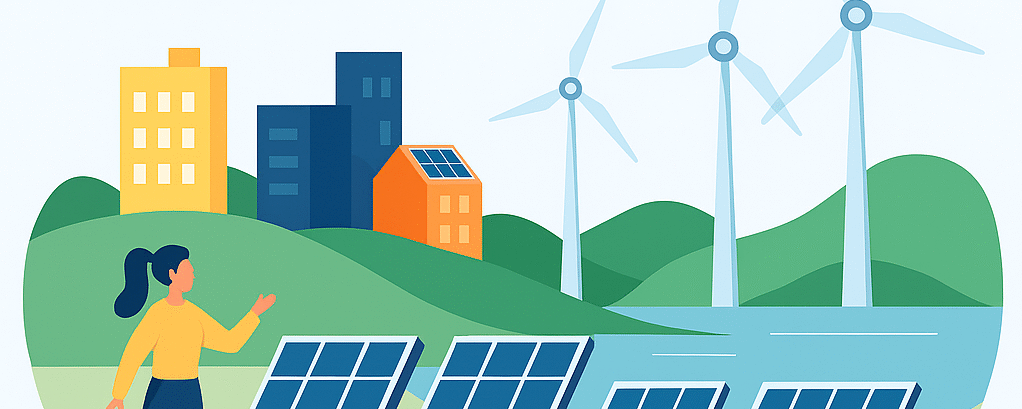As we navigate the often choppy waters of rising energy costs in 2025, solar power is shining brighter than ever as a beacon of financial relief. More than just an eco-friendly alternative, going solar presents a real opportunity to save money, putting more green in your wallet while helping the planet.
Harnessing the sun’s abundant energy means slashing those intimidating monthly electricity bills. It’s all about reducing grid dependence by generating your own power. Imagine saving 50–70% on electricity just by soaking up some rays!
But that’s not all. Governments worldwide are rolling out enticing incentives to boost solar adoption. Think tax credits, rebates, and net metering programs that could have you earning cash for surplus energy. These financial boosts make the initial investment in solar technology much more manageable.
So, in 2025, solar energy isn’t just a trend—it’s a smart economic move with lasting benefits.
Cutting Utility Costs with Solar Energy in 2025
In 2025, cutting down on utility costs with solar energy has never been easier or more effective. Thanks to innovative technological strides, solar panels are more efficient than ever. This means they can convert more sunlight into electricity, allowing households to benefit from their investment significantly.
With the capability to save up to 70% on your electricity bills, it’s clear that solar is a financially attractive option. Plus, additional savings can be realized by minimizing grid reliance and maximizing self-generated power.
Understanding Solar Panel Efficiency
Recent advancements have propelled solar panel efficiency to new heights. With improved materials and design, panels can capture more sunlight, even during less-than-ideal weather conditions.
Modern panels boast efficiencies that outpace those of previous years, making solar a smart economic choice. Choosing high-efficiency panels means getting the most bang for your buck, quicker return on investment, and more substantial savings in the long haul.
Seasonal Energy Savings
Seasonal changes can significantly impact how much solar energy your panels produce. During sunny months, production is at its peak, often generating more power than you need.
To maximize your savings year-round, consider installing a battery storage system. By storing excess energy produced during sunny seasons, you can draw on this reserve during cloudier months, ensuring consistent savings and energy security.
Financial Incentives and Tax Credits for Solar Panels
In 2025, the financial landscape for solar energy is more enticing than ever, thanks largely to robust government incentives. One standout example is the lucrative federal tax credit, allowing homeowners to reclaim up to 30% of their solar installation costs. This significant reduction in upfront expenses makes the switch to solar a no-brainer for many.
Federal and State Benefits
Besides federal initiatives, many states are doubling down with their own set of perks. Programs like net metering are increasingly popular, where homeowners receive credits for any excess energy their systems pump back into the grid. These credits can be used to lower future energy bills, further boosting financial savings from solar installations.
Consider this: with a combination of federal credits and state-specific programs, the initial investment in solar technology can be dramatically reduced. It’s not just about cutting costs; it’s about making solar power accessible to more people, helping secure a sustainable energy future for all.
Long-Term Return on Investment of Solar Energy
Investing in solar energy isn’t just a smart move for today; it’s a financial strategy with long-term benefits. While the initial cost of installing solar panels might seem hefty, the return on investment (ROI) over their lifespan is compelling. With solar panels lasting up to 25 years, homeowners can save thousands on energy bills over time.
Calculating Payback Periods
Understanding your payback period is crucial for seeing the real value of your solar investment. To calculate this, consider the total cost of your solar panel system, subtract any incentives, and then divide by annual savings.
For example, let’s say your system costs $10,000. With a government rebate of $3,000, your net cost is $7,000. If you save $1,500 annually on your energy bills, your payback period is just under five years.
Once that period is up, it’s mostly pure savings. Beyond the initial five years, you could see significant returns, making a notable difference in your financial landscape. Over a couple of decades, that could add up to tens of thousands saved, underscoring why more people are opting for solar as the way forward.
Conclusion: Solar Energy as a Smart Financial Choice
As we’ve explored, solar energy continues to be a powerful tool for financial savings in 2025. By significantly reducing electricity bills and taking advantage of enticing government incentives, homeowners can see immediate monetary benefits and a promising return on investment over the long term.
Switching to solar isn’t just about environmental stewardship—it’s about making a savvy financial decision that pays off for years. With minimal maintenance, like regular cleaning and periodic checks for damage, solar panels offer a durable and lasting solution to rising energy costs.
By opting for professional maintenance occasionally, you ensure your system runs smoothly, catching potential problems early before they escalate.
In a future where energy prices keep climbing, solar energy stands out as a reliable ally. It provides not only energy independence but also a way to secure your financial future, one sunbeam at a time.

